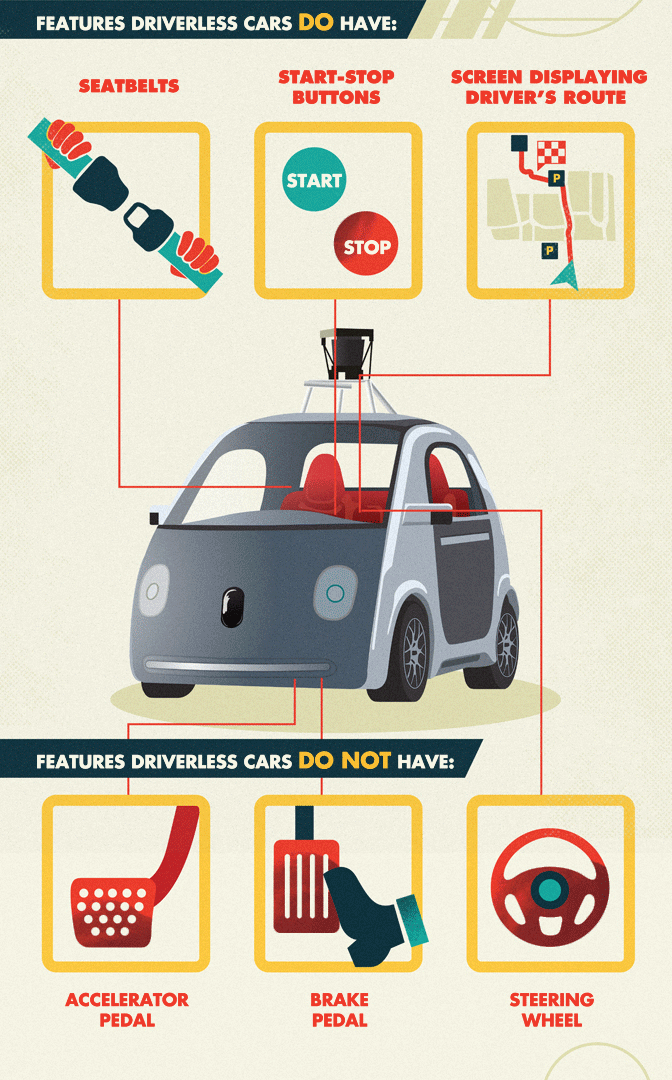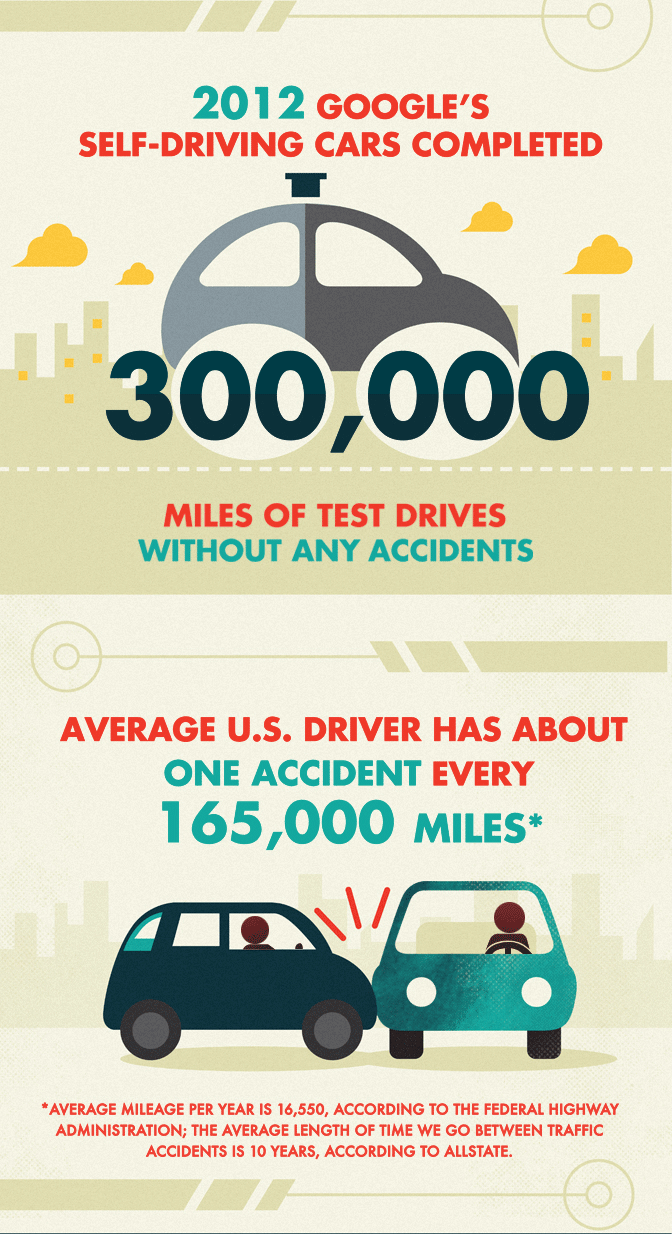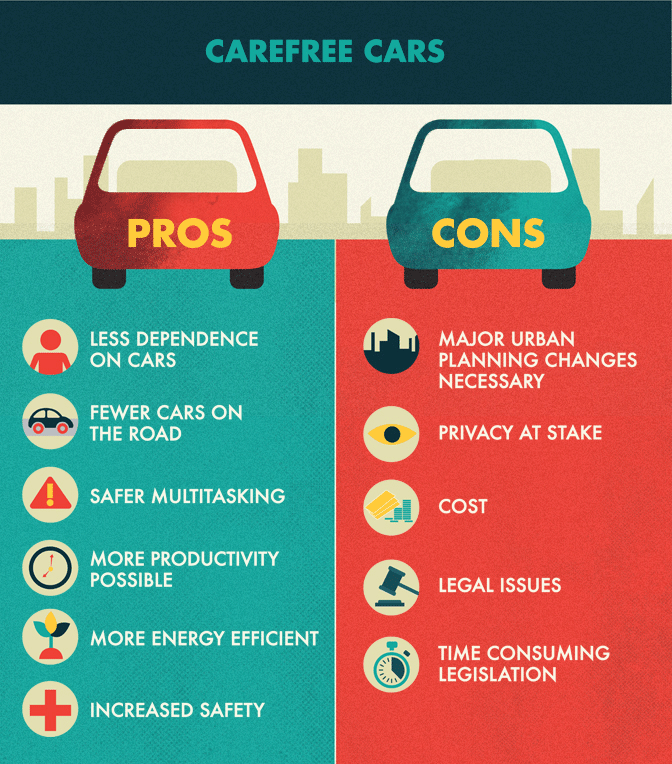Hands-Free Driving
Google’s New Driverless Car
One of the biggest tech stories of the year is definitely the unveiling of Google’s driverless car. The general story is this: Google is manufacturing some completely self-driving cars – no steering wheels, accelerator pedals, or brake pedals.
But the details are pretty fascinating, and even more interesting are the broad societal implications.
How the Driverless Car Works
Google’s driverless car uses cameras, lidar (light radar) system, and software called Google Chauffeur. A Velodyne 64-beam laser scans the surrounding environment in 3D and combines what it finds with high-resolution maps.
That’s really the essence of it. To dive deeper, you’d need a background in engineering and a bit more information from Google. But the results are impressive.
“The software can recognize objects, people, cars, road marking, signs, and traffic lights, obeying the rules of the road and allowing for multiple unpredictable hazards, including cyclists. It can even detect road works and safely navigate around them,” the Guardian writes. Aside from that fancy tech, there are simpler innovations as well.
The bumper is made of foam and the windshield is actually flexible. Both of these features will reduce injury and lower the chance of death if the car does happen to hit a pedestrian, bicyclist, or other motor vehicle.
Google had been testing its technology on modified vehicles such as a Toyota Prius and a Lexus RX450h for a few years before unveiling in May, with unnamed partners, a driverless car.. Initially, Google is producing approximately 100 of these driverless cars.

Unlike the modified vehicles used for testing, these new driverless cars don’t have steering wheels, accelerator pedals, or brake pedals at all. There’s not much in them aside from seatbelts, start/stop buttons, and a screen that shows the route (with no Google ads, the company has noted).
The cars are all electric, which increases efficiency and the smoothness of the ride, and they can detect objects more than two football fields away. At this stage of their development, the cars are capped at a top speed of 25 mph.
The screens, aside from showing the route, also remind passengers to take a head count when they leave. The idea is that these cars aren’t quite a replacement for your personal car yet, but more so “a replacement for the taxi without the human driver,” according to the Guardian.
The Consequences
The technology is cool, but the implications for society could be huge. For one, despite the expected fears many of us have of driverless cars traversing our streets, these are surprisingly much safer than human-operated vehicles.
Even back in 2012, Google’s self-driving cars were safer than the average driver. Barring a couple of incidents in which human drivers made mistakes, these cars have been accident-free.
In a clever attempt to help people feel more comfortable with this emerging technology, the front of Google’s new self-driving car was purposefully designed to look like a cute little face.

The ideology surrounding Google’s self-driving car revolution is that the more self-driving cars there are on the roads, the more the cars around us will fall in line with road laws (including speed limits).
These cars could lead to more predictable and safer roads, making it even easier for self-driving vehicles to travel around a city without unexpected obstructions caused by accidents.
Aside from safer roads, self-driving cars could also do away with the common idea that every household needs a car.
Self-driving cars could be based in pods distributed around a city (similar to current bike-sharing and car-sharing programs) and then deployed as people request, or at specific times that the drivers reserve ahead of time.
If we look at the bigger picture, most cars today are used just a tiny fraction of the time. With shared driverless cars, much urban and suburban land could be cleared up for more useful purposes.
Lastly, with less attention devoted to driving, we could have more time to work, play, chat, reflect on the meaning of life, or use our hands and minds in some other ways while commuting around town.
(Actually, we can already do that in public transit, but that’s another story.) We’d be much more productive and have an improved quality of life.
The ease of driverless cars could also result in a greater tolerance for traffic, keeping each of us encapsulated in our own little bubble.

Rules and Regulations
One of the biggest obstacles to self-driving cars is actually the legal system. Cities and states would need to legalize self-driving cars, which is not easy when many people are intuitively unsure how safe they are.
There’s also the worry that without the right rules and practices, drivers will lose a sense of independence and privacy (since self-driving cars can track the passenger’s physical whereabouts).
Aside from that, there are countless laws assuming a driver is at the wheel; these would need to be modified to broaden the terminology.
California has been a leader in self-driving legislation. As the home of Silicon Valley and Google, this isn’t surprising. However, even the Golden State struggles with it.
California recently backtracked on its legal progress by requiring self-driving cars to include a steering wheel, brake pedal, and accelerator.
As noted, these aren’t standard in Google’s new cars, so they will now need to be retrofitted, even though those items aren’t needed to drive the car.
Interestingly enough, this change in California policy came right after Google made it known these cars would be capable of driving 10 miles per hour over the speed limit.
The reasoning is logical and follows what we are taught in driving school: It’s more important to drive with the flow of traffic than to drive the speed limit. The flow of traffic is often 10 miles per hour over the speed limit, so it makes sense that Google’s car should be able to reach that level for the safest driving.
Nonetheless, the change upset some people, so the legislature shot back with another cost and hindrance to the new cars.
The Long Drive Ahead of Us
Clearly, self-driving technology has a lot of potential and can help society in a number of ways. However, technological advancements also come with unintended consequences.
It’s important we give thought to as many of the potential repercussions as possible and work to avoid what we don’t want to happen, both now and in years to come.
Lloyd Alter, an urban design expert who has been blogging about such topics on TreeHugger for quite some time, believes we should take caution.
“The autonomous car will likely be shared, smaller, lighter, and slower, and there will likely be about a tenth as many of them.
We have to be careful and shape the future of transport in a positive way in order to improve our cities,” he said. “Urban planners and theorists have to start thinking about this or we will screw it up again.”
Others wonder if this technology really counts as progress in the grand scheme of things. As longtime leaders of sustainable development matters and public policy, attorneys Kaid Benfield and Lee Epstein pose the question:
“Could this be a step not forward but back, to an era when the emphasis was all about moving as many cars as possible as quickly as possible, rather than on creating better environments for humans that don’t rely so much on cars?”
So the big question is, do we want something because it’s new and cool or do we want something because it’s better? In the case of electric cars, we get both. In the case of self-driving cars, we need to be careful how we plan around them, how we use them, and how we let them shape our world before we can really answer that question.
In many respects, we can say, “The future has arrived!” But before we get too excited, we also need to consider what’s next.
Embed the article on your site

